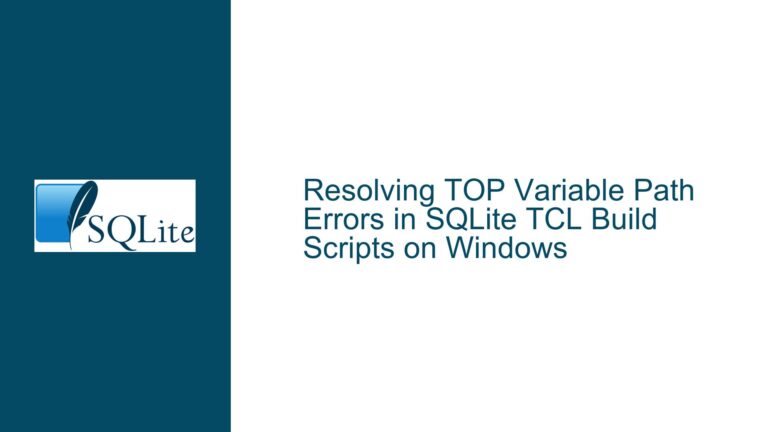Improving SQLite PRAGMA Documentation for Clarity and Usability
Standardizing PRAGMA Default Settings and Behavior Descriptions
The SQLite PRAGMA statements are a powerful set of commands that allow developers to query and modify the behavior of the SQLite database engine. However, the current documentation for PRAGMA statements lacks a standardized way to present default settings and the nature of changes made by each PRAGMA. This can lead to confusion, especially for developers who are new to SQLite or those who need to quickly reference the behavior of a specific PRAGMA. The absence of a clear, consistent format for documenting default values and the scope of changes (whether they are transient, persistent, or purely informational) makes it difficult to understand the implications of using a particular PRAGMA.
The core issue revolves around two main documentation shortcomings. First, the default settings for PRAGMA statements are not consistently highlighted or easily accessible. Developers often have to sift through lengthy descriptions to find the default value, which is inefficient and error-prone. Second, the documentation does not clearly categorize PRAGMAs based on their behavior—whether they are read-only, modify connection-specific settings, alter the database temporarily, or make persistent changes that affect future connections. This lack of clarity can lead to misuse of PRAGMAs, unintended side effects, or missed optimizations.
For example, consider the PRAGMA journal_mode command, which controls the journaling behavior of the database. The documentation explains the various modes (DELETE, TRUNCATE, PERSIST, MEMORY, WAL, OFF) but does not immediately state the default mode (DELETE). Similarly, it does not explicitly clarify that changing the journal mode affects the current connection and persists across subsequent operations until the connection is closed or the mode is changed again. This ambiguity can cause confusion, especially when developers assume that changes made by a PRAGMA are either permanent or transient without clear documentation.
To address these issues, the documentation should adopt a standardized format that includes the following elements for each PRAGMA:
- Default Setting: Clearly state the default value or behavior of the PRAGMA.
- Behavior Category: Categorize the PRAGMA based on its impact—whether it is informational, connection-specific, temporary, or persistent.
- Scope of Change: Explicitly describe whether the change applies to the current connection, the database file, or future connections.
By implementing these changes, the documentation would become more user-friendly, enabling developers to quickly understand and utilize PRAGMAs effectively.
Ambiguity in PRAGMA Behavior Categories and Default Values
The ambiguity in PRAGMA behavior categories and default values stems from the lack of a unified framework for describing these aspects in the documentation. Currently, developers must infer the behavior of a PRAGMA by reading through detailed explanations, which often leads to misinterpretation or oversight. This problem is exacerbated by the fact that PRAGMAs can have vastly different scopes and effects, ranging from purely informational queries to persistent changes that alter the database file itself.
One of the primary challenges is that PRAGMAs can be categorized into four distinct behavior types, but this categorization is not explicitly documented. These categories are:
- Report-Only PRAGMAs: These PRAGMAs provide information about the database or its current state without making any changes. Examples include
PRAGMA database_list, which lists all attached databases, andPRAGMA table_info, which returns metadata about a table’s columns. - Connection-Specific PRAGMAs: These PRAGMAs modify settings that apply only to the current database connection. The changes are transient and do not persist after the connection is closed. Examples include
PRAGMA foreign_keys, which enables or disables foreign key constraints for the current connection, andPRAGMA cache_size, which adjusts the size of the in-memory cache for the current session. - Temporary Change PRAGMAs: These PRAGMAs modify the database or its behavior temporarily, but the changes are not saved to the database file and do not affect subsequent connections. An example is
PRAGMA auto_vacuum, which can be set to control the auto-vacuum behavior for the current session but does not alter the database file itself. - Persistent Change PRAGMAs: These PRAGMAs make changes that are saved to the database file and are automatically applied to all subsequent connections. Examples include
PRAGMA user_version, which sets a user-defined version number stored in the database file, andPRAGMA application_id, which sets an application-specific identifier stored in the database header.
The absence of clear categorization leads to confusion, especially when developers assume that a PRAGMA’s changes are persistent when they are actually connection-specific, or vice versa. For instance, a developer might use PRAGMA synchronous to disable synchronous writes for performance reasons, assuming the change is connection-specific, only to discover that it affects all subsequent connections because the change is persistent.
Additionally, the default values for PRAGMAs are often buried in the documentation, making it difficult to determine the initial state of a setting. For example, the default value for PRAGMA journal_mode is DELETE, but this information is not prominently displayed. Similarly, the default value for PRAGMA foreign_keys is OFF, which can lead to unexpected behavior if developers assume foreign key enforcement is enabled by default.
To resolve these issues, the documentation should adopt a standardized notation or set of keywords to clearly indicate the behavior category and default value for each PRAGMA. This would eliminate ambiguity and ensure that developers can quickly and accurately understand the implications of using a particular PRAGMA.
Enhancing PRAGMA Documentation with Standardized Formats and Cheat Sheets
To address the issues of ambiguity and inefficiency in the current PRAGMA documentation, a comprehensive overhaul is needed. This overhaul should focus on introducing standardized formats, clear behavior categorization, and easy-to-reference cheat sheets. These enhancements would significantly improve the usability of the documentation and reduce the likelihood of errors or misunderstandings.
Standardized Format for PRAGMA Documentation
Each PRAGMA entry in the documentation should follow a standardized format that includes the following sections:
- Description: A brief explanation of the PRAGMA’s purpose and functionality.
- Default Value: The default setting or behavior of the PRAGMA, clearly highlighted for quick reference.
- Behavior Category: A clear indication of whether the PRAGMA is report-only, connection-specific, temporary, or persistent.
- Scope of Change: A detailed explanation of the scope of any changes made by the PRAGMA, including whether they affect the current connection, the database file, or future connections.
- Usage Examples: Practical examples demonstrating how to use the PRAGMA in common scenarios.
For example, the documentation for PRAGMA journal_mode could be structured as follows:
PRAGMA journal_mode
- Description: Controls the journaling mode used by the database, which affects how transactions are logged and recovered.
- Default Value: DELETE
- Behavior Category: Connection-Specific
- Scope of Change: Changes the journaling mode for the current connection. The mode persists for the duration of the connection but does not affect other connections or the database file.
- Usage Examples:
PRAGMA journal_mode = WAL; -- Enable Write-Ahead Logging mode PRAGMA journal_mode; -- Query the current journaling mode
Behavior Categorization and Keywords
To further enhance clarity, the documentation should introduce a set of keywords or symbols to denote the behavior category of each PRAGMA. These keywords could be displayed prominently alongside the PRAGMA name, making it easy to identify the type of PRAGMA at a glance. For example:
- Report-Only: [R]
- Connection-Specific: [C]
- Temporary Change: [T]
- Persistent Change: [P]
Using these keywords, the documentation could present a concise summary of each PRAGMA’s behavior. For instance:
PRAGMA database_list[R]: Lists all attached databases.PRAGMA foreign_keys[C]: Enables or disables foreign key constraints for the current connection.PRAGMA auto_vacuum[T]: Controls the auto-vacuum behavior for the current session.PRAGMA user_version[P]: Sets a user-defined version number stored in the database file.
Cheat Sheets and Quick Reference Tables
In addition to the detailed documentation, the inclusion of cheat sheets or quick reference tables would provide developers with a convenient way to access essential information about PRAGMAs. These tables could summarize the key attributes of each PRAGMA, including its default value, behavior category, and scope of change. For example:
| PRAGMA Name | Default Value | Behavior Category | Scope of Change |
|---|---|---|---|
| journal_mode | DELETE | Connection-Specific | Current connection only |
| foreign_keys | OFF | Connection-Specific | Current connection only |
| auto_vacuum | NONE | Temporary Change | Current session only |
| user_version | 0 | Persistent Change | Database file, all connections |
These tables could be included in a dedicated section of the documentation, allowing developers to quickly look up the information they need without navigating through lengthy descriptions.
Practical Implementation and Benefits
Implementing these changes would require a concerted effort to review and update the existing PRAGMA documentation. However, the benefits would far outweigh the costs. Developers would be able to quickly and accurately understand the behavior of each PRAGMA, reducing the likelihood of errors and improving overall efficiency. The standardized format and cheat sheets would also make the documentation more accessible to new users, lowering the barrier to entry for working with SQLite.
In conclusion, enhancing the PRAGMA documentation with standardized formats, clear behavior categorization, and easy-to-reference cheat sheets would significantly improve its usability and effectiveness. By addressing the current shortcomings, SQLite can provide developers with the tools they need to fully leverage the power of PRAGMAs and optimize their database operations.






